| |

The
Kissimmee Skycoaster
Ride
It And Know What It Means To Look The Devil In The Eye.
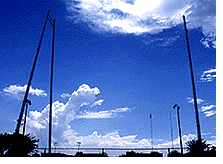 Friends, family and curious
strangers alike often ask me what's the single scariest thrill
ride I've ever encountered and it's high time to fess up with
an unequivocal answer: The Kissimmee Skycoaster. Its operators
humbly call this stand-alone attraction the "Tallest Thrill
Ride in Florida," but that bit of hype actually undersells
it. Not only is this Skycoaster taller, by a shocking degree,
than any other scream machine in the Sunshine State, it's the
tallest of its kind anywhere on earth. Dig this, my brothers and
sisters: the Kissimmee Skycoaster measures three hundred feet in height. Friends, family and curious
strangers alike often ask me what's the single scariest thrill
ride I've ever encountered and it's high time to fess up with
an unequivocal answer: The Kissimmee Skycoaster. Its operators
humbly call this stand-alone attraction the "Tallest Thrill
Ride in Florida," but that bit of hype actually undersells
it. Not only is this Skycoaster taller, by a shocking degree,
than any other scream machine in the Sunshine State, it's the
tallest of its kind anywhere on earth. Dig this, my brothers and
sisters: the Kissimmee Skycoaster measures three hundred feet in height.
I almost couldn't
bring myself to do it.
.
. . . . . . . . . . . . . . . . . . . . . . .
Bill Kitchen
is the man we can thank for cooking up the Skycoaster. An accomplished
pilot, hot air balloonist and pro-rated skydiver (with more than
500 jumps to his credit), Kitchen knows well the exhilaration
of soaring to - and falling from - great heights. Up until 1990,
he had worked in the broadcasting industry building radio and
television stations. That year, however, he took the plunge into
the world of thrill-mongering and got his feet wet in the bungee
jump business, just like Stan Checketts of S&S Power. And
also like Checketts, Kitchen soon moved on to bigger and better
things. Despite his spotless bungee jump safety record, Kitchen
decided he wanted to create a new type of skydiving thrill ride
with less inherent risk than that particular recreation.
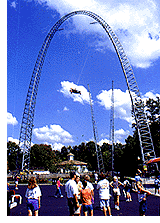 Like so many flashes of genius, Kitchen's grand scheme started as a quick
sketch on a dinner napkin. What he envisioned was not a bungee-style
vertical drop but an acrobatic swoop through a radial flight path,
with passengers suspended from heavy-duty steel cables. Anywhere
from one to three riders at a time would climb into custom-designed
"flight suits" and get winched backwards to the top
of a launch tower. His finest inspiration: at the peak, one rider
would pull a rip cord, releasing them from the winch cable and
initiating the trajectory. Kitchen went on to build a scale model
in his living room, enlisting toy soldiers as test pilots, and
once satisfied that the concept was practical, he drew up detailed
plans for a 100-foot-tall prototype. The Skycoaster was born. Like so many flashes of genius, Kitchen's grand scheme started as a quick
sketch on a dinner napkin. What he envisioned was not a bungee-style
vertical drop but an acrobatic swoop through a radial flight path,
with passengers suspended from heavy-duty steel cables. Anywhere
from one to three riders at a time would climb into custom-designed
"flight suits" and get winched backwards to the top
of a launch tower. His finest inspiration: at the peak, one rider
would pull a rip cord, releasing them from the winch cable and
initiating the trajectory. Kitchen went on to build a scale model
in his living room, enlisting toy soldiers as test pilots, and
once satisfied that the concept was practical, he drew up detailed
plans for a 100-foot-tall prototype. The Skycoaster was born.
The original
Skycoasters he sold hung their swing cables from a portable crane,
but Kitchen soon designed a galvanized steel arch, capable of
withstanding 140 mile per hour winds, that would serve as the
attraction's primary structure. In 1993, Super Speed Fun Park
of Panama City Beach, Florida purchased the first of these permanent,
arch-supported 100-footers and additional orders rushed in from
locations in the U.S. and as far away as Brazil, Cyprus, Great
Britain, Japan and Kuwait. In 1994, Kennywood took delivery of
a 180-foot-tall unit, the first to be constructed inside a major
amusement park. Not too long after, MGM Grand Adventures theme
park in Las Vegas broke the 200-foot barrier with its SkyScreamer,
accurately described by Dan Wade, MGM Grand's President and CEO,
as "a no guts, no glory, must-ride attraction." That
monster rose 250 feet, dropping riders from a 220-foot apogee.
Within five years after Kitchen's maiden Skycoaster took flight,
more than 70 were in operation around the globe. And MGM's SkyScreamer
didn't hold its record long; Kissimmee's 300-footer was unveiled
in November of 1997. Since then, no one has dared to ask for one
bigger.
.
. . . . . . . . . . . . . . . . . . . . . . .
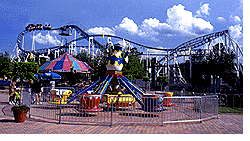 Old Town, in Kissimmee (that's "Kiss-EM-me," not "KISS-em-me,"
as I repeatedly pronounced it), is not what you'd call one of
Central Florida's most heart-racing amusement centers. A touristy
little shopping promenade, Old Town does tempt us with a compact
steel coaster called the Windstorm (pictured at left),
a cool walk-through haunted house, a Ferris wheel, a couple of
"spin 'n' spew" flat rides and some assorted kiddie
rides. Not bad, really, but it's the kind of family entertainment
center you can find in cities all over America. And with Walt
Disney World, Universal Studios Orlando, SeaWorld Orlando and
so much more just a hop, skip and a jump away, Old Town sorta
pales in comparison. But for the iron-willed Ride Warrior, it
will always be part of any go-for-the-jugular junket. For standing
right next to Old Town, and looming far above it, is That Big
White Thing. Old Town, in Kissimmee (that's "Kiss-EM-me," not "KISS-em-me,"
as I repeatedly pronounced it), is not what you'd call one of
Central Florida's most heart-racing amusement centers. A touristy
little shopping promenade, Old Town does tempt us with a compact
steel coaster called the Windstorm (pictured at left),
a cool walk-through haunted house, a Ferris wheel, a couple of
"spin 'n' spew" flat rides and some assorted kiddie
rides. Not bad, really, but it's the kind of family entertainment
center you can find in cities all over America. And with Walt
Disney World, Universal Studios Orlando, SeaWorld Orlando and
so much more just a hop, skip and a jump away, Old Town sorta
pales in comparison. But for the iron-willed Ride Warrior, it
will always be part of any go-for-the-jugular junket. For standing
right next to Old Town, and looming far above it, is That Big
White Thing.
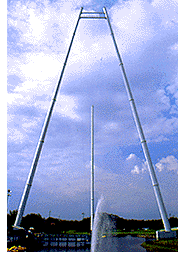 Even though you can see it from miles away, it's not until you're standing
directly beneath this Skycoaster that you can appreciate its overwhelming
presence. Straddling the reflective waters of a man-made pond,
two whitewashed obelisks rise at gentle angles to be joined at
the top by a pair of horizontal braces. The single vertical launch
tower rises behind the main arch at the far end of the lagoon,
aircraft warning beacons rhythmically flickering at each summit.
A soft, green meadow undulates around the water's edge. If one
can temporarily forget the vile intentions behind its design,
the entire apparatus is beautiful, in a stark, commanding way. Even though you can see it from miles away, it's not until you're standing
directly beneath this Skycoaster that you can appreciate its overwhelming
presence. Straddling the reflective waters of a man-made pond,
two whitewashed obelisks rise at gentle angles to be joined at
the top by a pair of horizontal braces. The single vertical launch
tower rises behind the main arch at the far end of the lagoon,
aircraft warning beacons rhythmically flickering at each summit.
A soft, green meadow undulates around the water's edge. If one
can temporarily forget the vile intentions behind its design,
the entire apparatus is beautiful, in a stark, commanding way.
But then you
watch as some poor fool (or gathering of fools) is fastened to
the cables hanging from the A-frame support and slowly hauled
up through the ether, only to fall, shrieking with unabashed terror.
Yeah, it sure is beautiful... like a gold-plated guillotine.
.
. . . . . . . . . . . . . . . . . . . . . . .
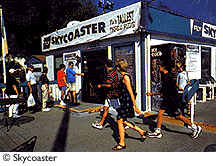 Riders first make their reservations in a little office on the observation
deck. A ticket for myself and the equally disturbed pal who "flew"
with me came to $64.00. Yes, it ain't cheap, but take my word;
it's money well spent. (I should also mention that when located
inside pay-one-price amusement parks, Skycoasters are "upcharge"
attractions, meaning that they require a separate expense to ride
there, as well). Riders first make their reservations in a little office on the observation
deck. A ticket for myself and the equally disturbed pal who "flew"
with me came to $64.00. Yes, it ain't cheap, but take my word;
it's money well spent. (I should also mention that when located
inside pay-one-price amusement parks, Skycoasters are "upcharge"
attractions, meaning that they require a separate expense to ride
there, as well).
For an additional
fee, you can buy a videotape of your experience, but I vetoed
that idea. I figured that if I fainted, lost control of my bowels,
or something worse, it wasn't anything I'd need to watch over
and over again. While they sent my credit card number off for
authorization, my flight partner and I stood at the window and
gazed out at the view. That's when he first noticed the radar
gun and digital numeric panel; as riders achieve maximum velocity
at the bottom of the swing, the gun measures and displays their
speed. Nice touch. But know this: my buddy spent many years with
Ringling Bros. performing as a trapeze and human cannonball artist
and even he was unnerved. "You pull the rip cord,
okay?" I pleaded.
We didn't
have to wait at all before riding and in hindsight, that was beneficial;
with more time to think it over, I'd have probably turned tail
and run. After grabbing our tickets, we strolled down a walkway
alongside the pond to the pre-flight shed and, gingerly putting
one foot in front of the other, I began to get a little light-headed.
Maybe it wasn't too late to change my mind...
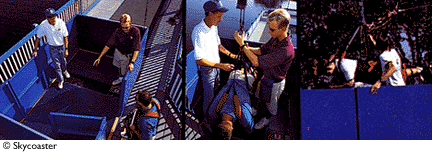
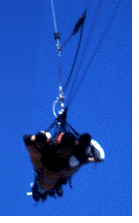 Inside the shed, we're fitted into the flight suits. The harnesses are laid
face down on the floor and we step into a pair of fabric loops
at the bottom. The attendants lift the harnesses up and tell us
to shimmy through a web of black straps until our shoulders hit
the pads at the top. They then move behind us and do some custom-tailoring,
cinching and tightening the suit all the way down our backs. The
fit is pretty snug, both comforting and unsettling. I learned
after the fact that Federal Aviation Administration-approved parachute
manufacturers assemble Skycoaster formal wear and that the metal
cables to which we were about to entrust our lives can bear loads
up to 9000 pounds. Unfortunately, I didn't have that consoling
information at the time. Inside the shed, we're fitted into the flight suits. The harnesses are laid
face down on the floor and we step into a pair of fabric loops
at the bottom. The attendants lift the harnesses up and tell us
to shimmy through a web of black straps until our shoulders hit
the pads at the top. They then move behind us and do some custom-tailoring,
cinching and tightening the suit all the way down our backs. The
fit is pretty snug, both comforting and unsettling. I learned
after the fact that Federal Aviation Administration-approved parachute
manufacturers assemble Skycoaster formal wear and that the metal
cables to which we were about to entrust our lives can bear loads
up to 9000 pounds. Unfortunately, I didn't have that consoling
information at the time.
Once we're
bundled up, the attendants hand us a small plastic rod at the
bottom of the harness to carry and we shuffle out to a blue booth
directly beneath the arch. Treading unsteadily to that little
enclosure, I felt like I was on my way to the gallows. One ride
operator asked who was going to pull the rip cord. Without a second's
hesitation, my friend said, "He will." Swell.
Once we're
inside, the door is closed and a hydraulic scissor-lift mechanism
beneath the booth begins to lift us up to meet the cables. Being
that I was the one to trigger the actual descent, I was told to
stand on the right. The attendants again work behind us, rigging
the swing and hoist cables to our flight suits. We step onto the
rods at our feet and are given the final instructions. "Lock
your arms together and keep them locked during the free fall.
Once you're past the base of the arch, you can spread your arms.
Wait till you hear me say 'Three, two, one, Fly,' then pull the
rip cord." Suddenly, we lurch into a prone position, dangling
face-down off the floor like so much raw meat.
The booth
drops. We start to lift away. And my entire body begins to
tremble.
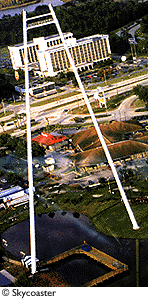 The pond, the grassy surroundings, Old Town, all of Kissimmee slowly recedes.
One hundred feet: "This isn't so bad, yeah, I'm okay..."
One hundred and fifty feet: "Wow, we're pretty high, aren't
we..." Two hundred feet: "As God is my witness, I will
never, ever, do this again." The pond, the grassy surroundings, Old Town, all of Kissimmee slowly recedes.
One hundred feet: "This isn't so bad, yeah, I'm okay..."
One hundred and fifty feet: "Wow, we're pretty high, aren't
we..." Two hundred feet: "As God is my witness, I will
never, ever, do this again."
It takes a
good, long while before the crest of the swing arch begins to
come into view and still there's plenty of climbing to do. The
blue booth where we boarded is now the size of a postage stamp.
Looking back down, the base of the rear launch column is finally
visible; we're getting close. With the harness drawn tight around
my ribcage, I can't even muster the strength to whimper, much
less scream.
Eventually,
the top of the gargantuan A-frame tower is directly in front of
us and at long last, we stop rising. We're about 300 feet above
the earth, lying flat, face down. And there's only one way to
end this intolerable agony. I think of those dear to me; please,
whoever up there is listening, just let me see them one more time...
"Three,
two, one, fly."
I manage to
find the orange rip cord handle with my quivering fingers and
give it a tug. With almost no effort, it pulls free.
Bombs away.
Instantly,
our feet rise and our heads drop before the swing cables catch
the slack. For one revolting second, we're in total freefall,
our bodies completely vertical. And now, I could scream.
Like a newborn. They must've heard me in Toledo.
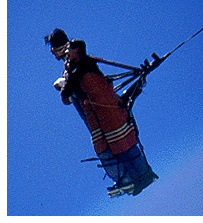 The cable pulls taut and our skulls tip back up. Faster and faster we dive,
slashing through the atmosphere like Icarus, melted wings and
all, roaring towards certain doom. As my life flashes before my
eyes, we surge down towards the planet's crust and before I know
it, our outstretched forms are whistling past the bottom of the
swing radius. The radar gun clocks our airspeed: 76 miles per
hour. The cable pulls taut and our skulls tip back up. Faster and faster we dive,
slashing through the atmosphere like Icarus, melted wings and
all, roaring towards certain doom. As my life flashes before my
eyes, we surge down towards the planet's crust and before I know
it, our outstretched forms are whistling past the bottom of the
swing radius. The radar gun clocks our airspeed: 76 miles per
hour.
As we begin
regaining altitude, I realize that I'm not going to expire. Horror
dissipates. Soaring back up, my pal and I extend our arms and
ecstasy radiates through every cell in my body; we're flying... we're flying! We reach the opposite zenith, pause, and
then swoop back down, gliding with all the majesty of eagles.
Back and forth we flow through the air... It's like nothing I've
ever experienced before and I want it to go on forever.
Of course,
it can't; after each pass through the arch, the height of the
swing diminishes. Eventually, the ride attendants extend a pole
with a loop for us to grab and they pull us back to the dock.
Once we were
out of the harnesses and back on solid ground, I was still pretty
shaky, no question about it. But my vow to keep off Skycoasters
forever was long forgotten.
Do this one
again, though? Yeah, someday... But not today.
.
. . . . . . . . . . . . . . . . . . . . . . .
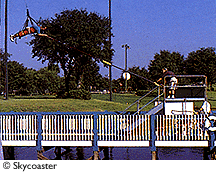 In 1998, Kitchen sold the Skycoaster to ThrillTime Entertainment International,
Inc. and went on to develop his latest high-tech machine, the SkyVenture® "Virtual Reality Skydiving Simulator."
Housed inside an upright tube and powered by a spinning airplane
propeller, the SkyVenture is a vertical-lift wind tunnel that
generates a column of air mighty enough to allow "skydivers"
to hover above it. The basic concept for such attractions isn't
new, but existing vertical-lift wind tunnels create an upward
thrust with greatest pressure in the center of the air flow. Divers
must carefully maintain their position at that point; otherwise,
they're tossed out of the flow. Kitchen's all-new computer-assisted
design creates a blast of air with greatest pressure at the edges
of the jet stream, allowing a total novice to safely and pleasurably
hover for as long as they desire. In 1998, Kitchen sold the Skycoaster to ThrillTime Entertainment International,
Inc. and went on to develop his latest high-tech machine, the SkyVenture® "Virtual Reality Skydiving Simulator."
Housed inside an upright tube and powered by a spinning airplane
propeller, the SkyVenture is a vertical-lift wind tunnel that
generates a column of air mighty enough to allow "skydivers"
to hover above it. The basic concept for such attractions isn't
new, but existing vertical-lift wind tunnels create an upward
thrust with greatest pressure in the center of the air flow. Divers
must carefully maintain their position at that point; otherwise,
they're tossed out of the flow. Kitchen's all-new computer-assisted
design creates a blast of air with greatest pressure at the edges
of the jet stream, allowing a total novice to safely and pleasurably
hover for as long as they desire.
Better still,
different virtual reality "environments" are projected
onto a 120-degree screen in front of the divers, adding to the
thrill. Participants can choose to leap out of a plane, jump off
a bridge, even drop out of the space shuttle. Pretty cool, no?
Kitchen's
first SkyVenture opened in Orlando, and he hopes to open more
around the country soon. And he also told me that he's working
on still more concepts for new thrill rides. Color me psyched.
Before we
bring this to a close, a final reality-warping reminder: Kitchen
has stated on several occasions that Skycoasters can indeed be
built taller than the Kissimmee model.
Do ya think
you have the nerve to ride a 500-foot-tall Skycoaster?
.
. . . . . . . . . . . . . . . . . . . . . . .
The
Kissimmee Skycoaster
- TOP SPEED:
Approx. 76 Miles Per Hour
- MAX. HEIGHT:
300 feet
- RIDE DURATION:
The longest minute and a half of your life
- CAPACITY:
Up to 3 Flyers per Drop
- MANUFACTURER:
ThrillTime Entertainment International, Inc.
Top |